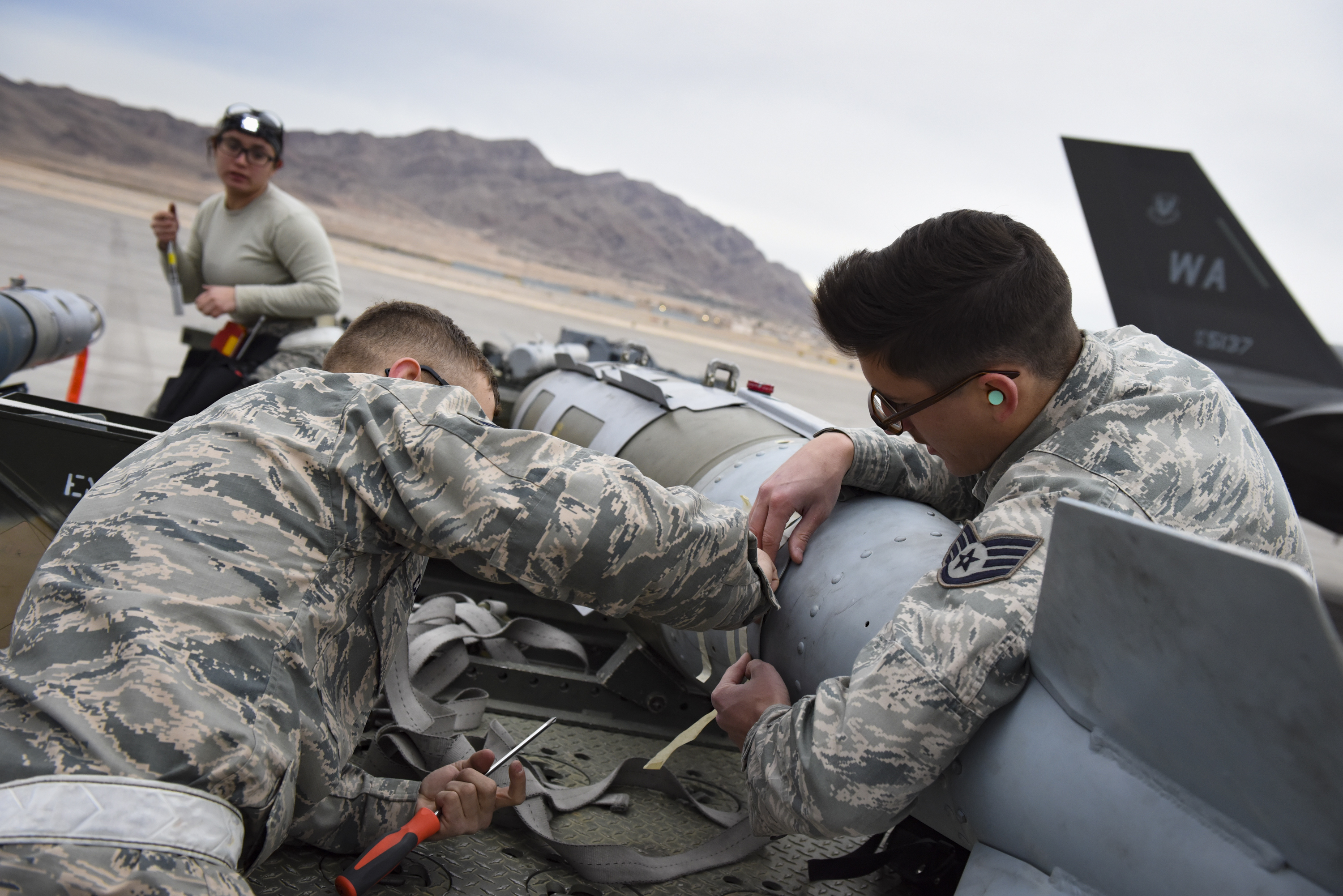
Donovan said there is some growth in USAF squadrons. Above, A1C Leilani Emilo, SrA. Jacob Carter and SSgt. Riley Collins of the 57th Aircraft Maintenance Squadron Lighting Aircaft Maintenance Unit load crew membersare working to transport a Mark 84 bomb to an F-35 Lightning II fighter jet at Nellis AFB, Nev., Jan. 8, 2018. USAF photo by A1C Andrew D. Sarver.
The recently released National Defense Strategy didn’t specify numbers of fighter squadrons, ships, or combat brigades the US should have, because that hasn’t been decided yet, Undersecretary of the Air Force Matt Donovan said Monday.
Speaking at an AFA Mitchell Institute event in Arlington, Va., Donovan said the Office of the Secretary of Defense and the Joint Staff are still “both working through the force-sizing construct,” and part of that will be to decide “which scenarios they’re going to go against.”
For the moment, the Air Force and the other services are following broad guidance from Defense Secretary Jim Mattis to ensure “the force structure we have now is as capable and lethal as possible,” Donovan said. However, there is some growth in USAF squadrons, he said, because “we’re still buying F-35s, and we’re not retiring anything else” in the fighter area, “so that is increasing our capacity.”
Donovan said “you’ll see more” on the force-sizing construct, which has evolved in the last 25 years, in the Fiscal 2020 budget. During the George H.W. Bush administration, the force was sized to fight “two and a half” major theater wars. The working notion was that the US should have enough forces to fight a “Desert Storm”-like war in the Middle East while having enough forces in reserve to respond to another contingency of equal size elsewhere, such as on the Korean Peninsula. There would be some additional forces on top of that to handle small-scale conflicts and brush wars, or to fight terrorist groups.
The construct evolved over the years—and as forces diminished—leading to concepts such as “win-hold-win,” in which the US could fight one major theater war while forcing a stalemate in a second, eventually winning the second war after achieving victory in the first. Other slogans arose as it became clear during the George W. Bush administration that US forces were actually only sized to fight one major theater war.
Joint Chiefs of Staff Vice Chairman USAF Gen. Paul Selva, meeting with reporters in late January, said the Joint Chiefs have yet to come up with a slogan that would define the new force-sizing construct. He noted that the new defense strategy will build “a global campaign” around all scenarios. “We’ll have those two major plans, which will be in tension with one another,” Selva said. “And that will help define the capabilities and capacities that will need to be built inside the forces.”
Selva also said the scenarios are important—and different than they’ve been—because different scenarios emphasize different forces. “Any fight with China, if it were to come to blows, will be largely a maritime and air fight,” Selva said, adding that it’s not that the Army and Marines would be excluded, but the nature of the conflict would not emphasize them. By contrast, “the Russia global problem set is largely an air and ground fight, supported by elements of our maritime component,” which would lead things off in order to resupply forces in Europe.
“That actually defines two separate but overlapping sets of capabilities and capacities,” he noted, and that’s called out in the NDS. The Joint Staff has decided not to take the easy out and simply call all other conflicts a “lesser included case,” but to define the specific requirements of each, and if the nation chooses not to fu?nd them, say “we are assuming risk … because we can’t do this set of tasks. We either appropriate the funds to get those tasks done or we can articulate the risk. And that’s the process we’re going through right now.”
Selva said the work is only in the “opening phases” and advised reporters to “stay in touch.”